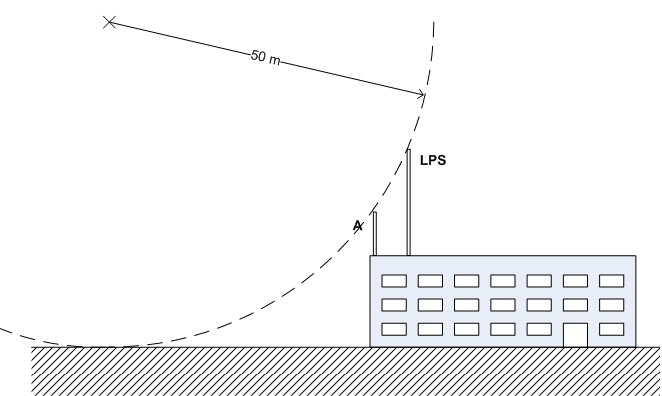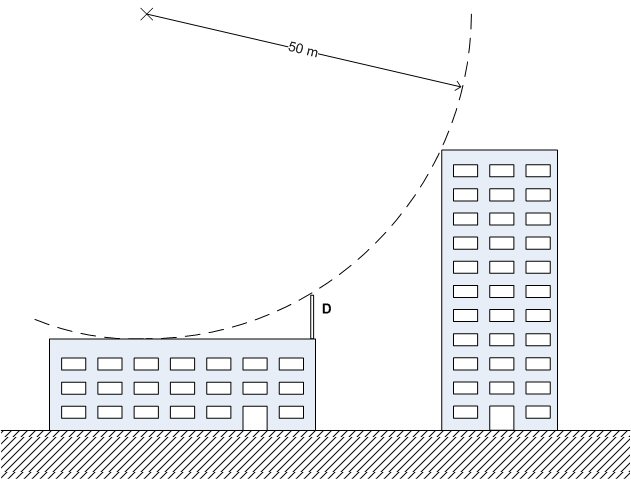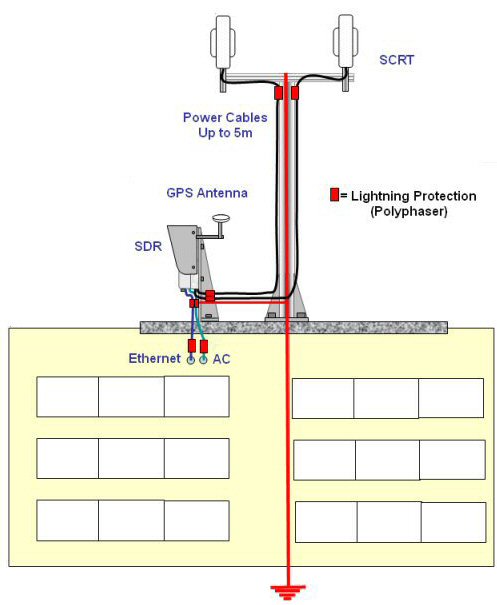
A direct lightning strike to a component (antenna, SCRT or SDR) of the HiperMAX-microMicroMAX-SDR system will cause unavoidable and catastrophic damage. Therefore lightning protection measures fall into two categories:
(a) Strike Avoidance: Implement measures to ensure that the probability of a direct strike on the equipment is very low. This normally requires the presence of an effective lightning protection system on the building or structure where the HiperMAX-microMicroMAX-SDR system is deployed.
(b) Equipment Protection: In high risk lightning strike areas, additional surge protection can be applied to equipment interfaces.
This section provides general advice on industry recognised methods of deploying base station equipment such that direct lightning strikes are avoided as far as practically possible. Airspan recommends that an operator seeks specific advice from a lightning protection specialist when designing a new base station site.
5.1.1.1 Roof Mounted Equipment (SDR-micro, SCRT's & Antennas)
A general rule that should always be applied is that any equipment supporting pole or structure on the roof of a building should be electrically connected to the building ground at the base, but at no other point. In order to minimise the probability of a direct strike at the equipment, the pole or structure should be no taller than is necessary to support the antennas to the required height.
In the example below the equipment at location ‘A’ is clearly exposed to a strike.

Airspan recommends assessing the suitability of equipment placement by using the “rolling ball” method. The theory is such that, if a hypothetical ball of diameter 50 m “rolls” across the landscape, over buildings and structures including the roof-top equipment and lightning protection systems (if any), direct strikes are possible at any point that is touched by the hypothetical ball.
The location ‘A’ considered above can be protected by installing a lightning conductor. The lightning conductor will be effective if it is located such that the hypothetical rolling ball does not touch any part of the equipment being protected. In the figure below, the protection system is just high enough (or close enough) to provide protection.

Equipment on the roof of a low building can be protected by the proximity of nearby taller buildings as shown in the Figure below.

Airspan supplies optional surge protection kits for use with HiperMAX. These are generally only installed in geographies where lightning strikes are very common, ie. High risk areas.
The available kits are as follows:
LPK-SCRT-PWR-1: SCRT Power Lightning Protection Kit - consisting of 1x 48V surge arrestor
LPK-SDR-M-1: SDR-micro Lightning Protection Kit - consisting of 1x Ethernet & 1x mains surge arrestors
LPK-GPS-1: GPS Lightning Protection Kit - consisting of 1x TNC-TNC (M) surge arrestor + 1x 1m TNC-TNC (F) cable
This section details the site requirements for installing these optional surge protection kits.
5.1.2.1 SCRT Power Protection (LPK-SCRT-PWR-1)
The SCRT Power Protection kit provides surge protection for the 48V DC Power supply input of the SCRT. It can also be fitted to provide protection to the SDR-micro SCRT power outputs if the power cable used is >10m in length.
Kit Description:
TBA
Positioning Recommendations:
TBA
Mounting Requirements:
TBA
5.1.2.2 SDR-micro Protection (LPK-SDR-M-1)
The SDR-micro Protection kit provides surge protection for the Mains Power Input and the Ethernet network interface.
Kit Description:
TBA
Positioning Recommendations:
TBA
Mounting Requirements:
TBA
5.1.2.3 GPS Receiver Protection (LPK-GPS-1)
The GPS Receiver Protection kit provides surge protection GPS receive port on the SDR-micro or rack mounted GPS receiver.
Kit Description:
TBA
Positioning Recommendations:
TBA
Mounting Requirements:
TBA

|
Surge Protection Requirements |
|||
|
Type |
At SDR |
At SCRT |
At building Entry |
|
DC |
1 per SCRT |
1 |
|
|
AC |
1 |
|
1 (Optional) |
|
Ethernet |
1 |
|
1 (Optional) |
|
|
|
|
|